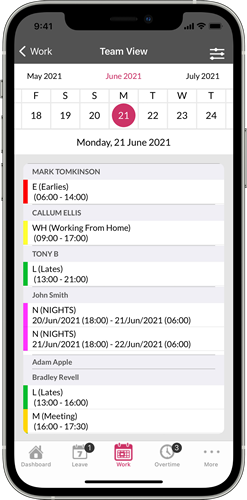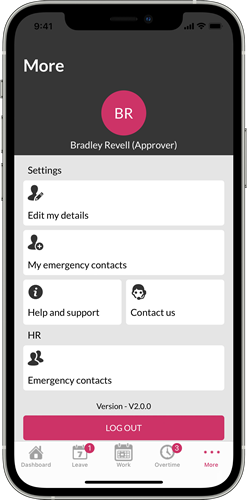At a time when food prices, energy bills and other living costs are rising, many people are worried about their financial situation. And for shift workers, this fear can be even more intense, due to lack of job security.
As an employer, there are many ways you can reassure your team and help them to plan ahead; all you need is the organisational tools to clearly communicate your staffing schedule.
Concerns growing around job security
Many of the sectors that employ a large number of shift workers – such as healthcare, retail and hospitality – have experienced a difficult couple of years as a result of the pandemic. This, combined with current cost of living pressures, has left many professionals feeling uncertain about their future.
Over three quarters (77%) of shift workers are worried about job security, according to a recent report – an 11% increase on last year. And these fears aren’t unfounded; the same survey found that almost half of shift workers whose roles were affected by the pandemic have not returned to the same job.
The current climate is challenging employers as well. 56% of companies admit to difficulties recruiting for shift-based roles. In light of this, more effort needs to be put into showing people that shift work is a stable career option – and here are four ways to achieve this:
1. Define roles and responsibilities for each team member
Shift patterns give staff greater flexibility around when they work, but there needs to be structure to make sure everyone is adding value. People work best when they’re given a clear brief – and that means putting task management systems in place to assign jobs to each team member.
When staff work to a clear task list, they feel more secure in their role as their skills are being used effectively. They also tend to be more productive, as they have a defined plan of action in place. The challenge for employers is finding a task planning and management tool that everyone can access before and during their shift.




Increasingly, businesses are turning to online task management platforms to assign workload. Daily, weekly and monthly jobs can be created on a digital dashboard and assigned to relevant, qualified team members – which they can review before each shift and check during the course of the day via a mobile app.
2. Make it easier to work as a team
Fluctuating rosters mean shift workers can struggle to form strong, communicative relationships with colleagues – which leaves them feeling less secure about the level of support they can access.

Giving colleagues greater visibility over who is working alongside them each shift makes it easier for teams to collaborate. And in many cases, the same online system that companies use for task management can provide this type of information.
Combined online shift planning and task management tools offer useful information about staff whereabouts, which help people work together productively. For example, a good scheduling tool will be able to record when a staff member is working from home versus when they’re on the premises, to help with meeting planning.
3. Give people more notice about upcoming shifts
It’s very difficult for shift workers to plan ahead in their lives if they don’t know when they are working. Yet, almost 40% of UK professionals in a shift-based role say they are given less than a week’s notice about their upcoming hours.
For many professionals it’s not just a case of planning when they are working, but how often – particularly employees on zero hours contracts. Fluctuating hours means fluctuating pay, so being able to see how many shifts they’ve been assigned each month helps people with their financial planning.
4. Create a healthier work/life balance
Shift work tends to involve longer hours than the standard 9-5:30 day, which can be very tiring. Scheduling too many 10 or 12-hour shifts in close succession can severely impact people’s energy and concentration levels, leading to employee burnout. And exhausted team members sometimes fear taking time off to recover, in case they’re deemed to be uncommitted.
It’s hard to feel secure and motivated when faced with an intense schedule, which is why some forward-thinking companies have started to factor recovery and downtime between shifts into staff rosters – as well as tracking their days on shift.
Using an online shift planner makes this process easier to manage, as companies can set rules around how many days their employees can work back-to-back before requiring a day off. Any plans that contravene this policy will be flagged up on the shift planning software, so an alternative team member can be rostered instead.
And if an employee does burn out, companies can block out the time they need to rest and recuperate – scheduling work for their return, to let people know that their job is secure.
Greater job security starts with solid forward planning
In uncertain times, it’s more important than ever for employers to create a stable environment for their workforce, as people thrive when they feel safe. But job security is not always easily achieved in shift-based businesses.
Using a shift planning platform with built-in task management tools like WhosOffice can help companies to get more organised and plan ahead, so staff have visibility over when they are working, how frequently, and the core tasks they’ll be carrying out.
By taking away the fear factor around fluctuating shift patterns, employers can focus on getting the best out of their teams – increasing the productivity and value each person brings to their business, and nurturing more loyal and longer-lasting employee relationships.
Try WhosOffice for free to see how your business can plan shifts better and offer your employees greater job security.
FREE TRIAL
Try WhosOffice for free before you sign up – no credit card required
EXPERT SUPPORT
We offer telephone and email support to our customers, at no extra cost
NO CONTRACTS
Cancel when you like with just 30 days’ notice
NO HIDDEN COSTS
We don’t believe in add-on charges or set-up fees
Book your Free WhosOffice Trial
Photo by Andrea Piacquadio of Pexels.com.


